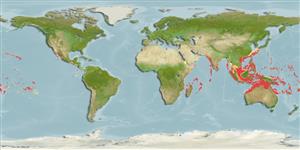Common names from other countries
Environment: milieu / climate zone / depth range / distribution range
Ecologia
marino associati a barriera corallina; distribuzione batimetrica 10 - 216 m (Ref. 37816), usually 10 - 150 m (Ref. 1602). Tropical; 32°N - 23°S
Indo-Pacific: Comoros to the Line, Marquesan and Society islands, north to southern Japan, south to New Caledonia. Recently found in southern Natal, South Africa (Ref. 11228).
Size / Peso / Age
Maturity: Lm ? range ? - ? cm
Max length : 35.0 cm TL maschio/sesso non determinato; (Ref. 9710)
Spine dorsali (totale): 7; Raggi dorsali molli (totale): 12-13; Spine anali 3; Raggi anali molli: 8. Post larvae with large white spots, the spots remaining part of the adult pattern, but become obscured with additional small white spots in the grey areas. The fins remain clear (Ref. 48635).
Sporadic distribution and habitat specific, preferring large coral heads on slopes prone to moderate currents (Ref. 9137, 48635). Adults usually in 20+ m depth; juveniles in shallow lagoons or protected bays (Ref. 48635). Minimum depth reported taken from Ref. 30874.
Life cycle and mating behavior
Maturità | Riproduzione | Deposizione | Uova | Fecundity | Larve
Myers, R.F., 1991. Micronesian reef fishes. Second Ed. Coral Graphics, Barrigada, Guam. 298 p. (Ref. 1602)
IUCN Red List Status (Ref. 130435)
CITES (Ref. 128078)
Not Evaluated
Threat to humans
Harmless
Human uses
Pesca: scarso interesse commerciale
Informazioni ulteriori
Nomi ComuniSinonimiMetabolismoPredatoriEcotossicologiaRiproduzioneMaturitàDeposizioneFecundityUovaEgg development
BibliografiaAcquacolturaProfilo di acquacolturaVarietàGeneticaElectrophoresesEreditarietàMalattieElaborazioneMass conversion
Strumenti
Special reports
Download XML
Fonti Internet
Estimates based on models
Preferred temperature (Ref.
115969): 21.2 - 29, mean 27.7 (based on 2628 cells).
Phylogenetic diversity index (Ref.
82804): PD
50 = 0.7500 [Uniqueness, from 0.5 = low to 2.0 = high].
Bayesian length-weight: a=0.01148 (0.00451 - 0.02922), b=3.06 (2.84 - 3.28), in cm Total Length, based on LWR estimates for this (Sub)family-body shape (Ref.
93245).
Trophic level (Ref.
69278): 4.0 ±0.66 se; based on food items.
Fishing Vulnerability (Ref.
59153): Low vulnerability (25 of 100).
